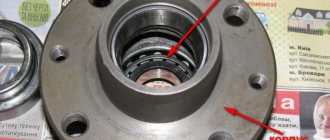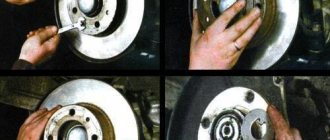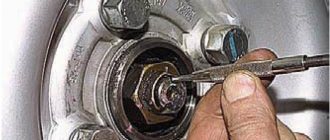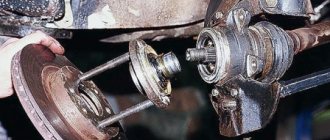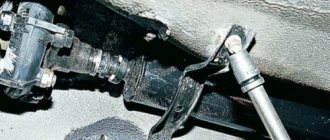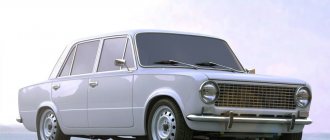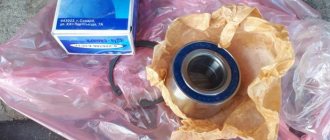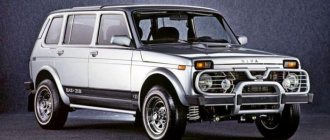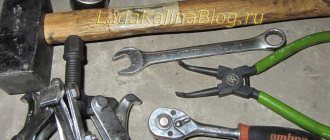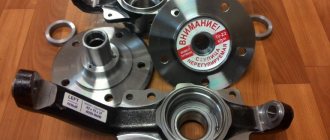To operate a vehicle safely, its wheels must rotate without any problems. If any appear, then nuances arise in driving the vehicle that can lead to an accident. Therefore, the condition of the hubs, axle shafts and their bearings must be periodically monitored, and if problems arise, they must be corrected in a timely manner.
- Steering knuckle
Malfunctions - How to increase wheel turnout
- Table: parameters of VAZ 2106 wheel bearings
Video: checking the wheel bearing on the “six”
- Video: replacing the wheel bearing
- Bearing replacement
Removing the axle shaft
↑ How to remove the front suspension wheel bearings
Unscrew the hub nut and remove the washer and inner race of the outer bearing.
If necessary, if the outer bearing cage is damaged along the way, we do not press out the outer ring of the bearing, but replace only its inner part. However, at the first opportunity we install a completely new bearing.
Carefully, trying not to damage the cuff, remove the hub together with the brake disc from the steering knuckle axis.
Using a 12mm wrench, unscrew the two guide pins and remove the brake disc and spacer ring from the hub.
We clean the inner cavity of the hub from old lubricant, wash all parts with kerosene and add fresh lubricant.
To remove the outer race of the outer bearing, secure the hub in a vice.
Using a beard, trying not to damage the hub, we hit the perimeter of the outer ring of the bearing and knock it out of the hub.
We take out the hub cuff by prying it off with a screwdriver.
A spacer bushing is installed under the cuff.
We remove the inner bearing from the hub in the same way as the outer one.
Installation and adjustment of new parts
The internal parts of the outer bearing are removed and the old oil is removed from the open hole. To get to the insides of the second part, you will need to remove the seal by pressing on it with a mounting spatula or a powerful flat-head screwdriver. It is recommended to wash the inner surface of the hub along with the rest of the fasteners with gasoline or diesel fuel. Sequence of further work.
Place the hub on 2 wooden boards and attach a hammer drill or other metal rod with a pointed end to the holder on the inside. Lightly tap the piece with a hammer. During operation, the switch must be moved so that the clamp comes out evenly. Turn the hub over and do the same operation on the other side. Now you need to study the condition of the surface of the hub seats. If you see signs of unscrewing the clamps, you should think about replacing it. You can slightly extend the “life” of the hub; for this they use an old method. Small notches should be made on the surface of the seats using a rod or chisel. After pressing the clamps, they will sit tightly on these bumps and will not return for some time.
Bushing diagram: 1. Outer ring race with rollers and inner ring 2. Outer bearing outer ring 3. Hub 4. Inner bearing outer race 5. Inner bearing race with rollers and inner ring 6. Cuff
Coat the new clips with a thin layer of thick grease and then insert one of them into the hole without distortion. We place an old part of the same size on top and, with light blows of a hammer, press the clamp into the saddle. Repeat the operation on the other side of the sleeve. Thoroughly lubricate the rollers, insert the bearing into the pressed ring. You need to start from inside the hub. Then install the oil seal as described in paragraph 3. Thoroughly lubricate and insert the second bearing
, lubricate both parts with plenty of oil. Wipe both working surfaces of the brake disc from grease and move the hub along the axis of rotation. Tighten the lock nut, lightly tighten with a wrench.
Further assembly is carried out in the reverse order, after completion of the VAZ front hub 2106
tightened with a nut with little effort. You can check that the adjustment is correct by pulling the suspended wheel with your hands by its upper and lower parts.
In this case, you should feel a slight play; do not tighten the bearing too tightly. After tightening the nut, screw in the point of the hammer, placing it on the side of the nut, opposite the groove in the pin shaft. By hitting it with a second hammer, a depression is made that prevents the nut from turning on its own.
↑ Installation of bearings
- We press the outer rings of the bearings in a vice, using the corresponding rings from old bearings.
- The old rings should be oriented with a smaller cone diameter inside the hub to facilitate their removal after pressing in the new rings.
- Using caution, you can press the inner races of the bearings with light blows of a hammer through the gasket.
- We put about 40 g of Litol-24 lubricant in the separator of the internal bearing and the internal cavity of the hub. We cover the new cuff with the same lubricant.
- Install the inner bearing into the hub.
- We install the spacer bushing.
Repair
If there is a need for repairs, it is recommended that replacing the front wheel hub bearing on a VAZ-2107 is carried out simultaneously for the front wheels.
Before disassembling, you need to check the amount of play by rocking the wheel, and it is recommended to do this in two planes:
- to turn left or right;
- swinging in a vertical plane.
It must be taken into account that the cause of the backlash may be:
- bearings;
- silent blocks or ball blocks.
Another important sign is that this fault causes the wheel to heat up excessively. If one of them is much warmer than the others, there is a need for repairs.
To carry out repair work you need to do the following:
- Disconnect the hub. This is done in accordance with the instructions above.
- Then remove the bearings.
- They are cleaned of old grease and inspected for damage and wear.
- If necessary, replace the front wheel bearings on the VAZ-2107.
- The bearings are lubricated and pressed into the hub.
Front hub VAZ 2106
One of the important elements of the VAZ 2106 chassis is the hub. This part allows the wheel to rotate. To do this, a wheel disk is screwed onto the hub, and the rotation itself is carried out thanks to a pair of wheel bearings. The main functions assigned to the hub are:
- connection of the wheel disk with the steering knuckle;
- ensuring a high-quality stopping of the car, since the brake disc is fixed to the hub.
To know how hub malfunctions manifest themselves, as well as how to make repairs, you need to familiarize yourself with the structure of this element. Despite the fact that the part is designed to perform complex functions, it is structurally quite simple. The main parts of the hub are the housing and bearings. The body of the part is cast, made of durable alloy and processed on turning equipment. The hub fails quite rarely. The main malfunction of the product is the wear and tear of the outer bearing races at the installation sites.
Preparing and disassembling the unit
The front rolling bearings are roller, cone type, consisting of two parts: external and internal. Good quality products are sold complete with the required amount of lubricant and two clamping nuts. The nuts differ in their thread, on one it is left-handed, on the other - right-handed, the first will fit the axis of the right axle, the second - to the left.
The manufacturer does not know which wheel will be replaced, so he completes the product with both nuts. Additionally, you need to purchase an oil seal, which is located at the rear of the hub and does not allow grease to leak out. You can carry out the work on a level surface, securing the car with the hand brake so that it does not roll away.
Before lifting the car with a jack, you need to pull out the metal boot covering the hub nut and loosen the latter with a 27 mm wrench. Then the wheel bolts are loosened, the car is jacked up and the wheel is removed. The next step is to remove the brake caliper, which is attached to the axle with 2 bolts; they need to be unscrewed, the part removed and moved to the side.
It is recommended to first remove the brake pads from the caliper, then it will be easier to put it back.
Now you can completely unscrew the nut, pull out the washer and remove the hub from the axle axle by hand. After this, you need to remove the old grease from all parts; it contains metal shavings.
Rounded fist
An equally important element of the six's chassis is the steering knuckle. Force is transmitted to it from the steering linkage through the lever, resulting in the rotation of the wheels of the front axle. In addition, ball joints (upper and lower) are attached to the assembly through the corresponding eyes. On the reverse side of the steering knuckle there is an axis on which the hub with bearings is placed. The hub element is fixed to the axle with a nut. The left trunnion uses a nut with a right-hand thread, and the right one uses a left-hand thread . This was done in order to prevent the bearings from being tightened while moving and to avoid overheating and jamming.
An additional function of the steering knuckle is to limit the rotation of the wheels, while the part rests against the levers with special protrusions.
Malfunctions
The resource of the steering knuckle is practically unlimited, if you do not take into account the quality of roads and neglect of adjusting the wheel bearings. Sometimes a product can travel 200 thousand km. The part is made of cast iron and can withstand heavy loads. However, if it fails, the owners of Zhiguli cars often replace it along with the bearings and hub. It is necessary to pay attention to the steering knuckle when the following symptoms appear:
- the car began to pull to the sides, and the problem is not eliminated by adjusting the wheel alignment;
- It was noticed that the wheels turned out at a smaller angle. The cause may be problems with both the steering knuckle and the ball joint;
- wheel break. This happens due to the breaking of the threaded part of the steering knuckle or the ball joint pin, which happens relatively often on Zhiguli cars;
- unadjustable play. If the wheel bearings were adjusted untimely or incorrectly, then in the places where they are installed, the steering knuckle axis will gradually wear out, which will lead to the appearance of play, which cannot be eliminated by adjustment.
Sometimes it happens that during car repairs a small crack is discovered on the steering knuckle. Some car enthusiasts advise fixing the problem by welding. However, it must be taken into account that safety directly depends on the condition of the steering knuckle. Therefore, such elements should not be repaired, but replaced with known good ones or new ones.
How to increase wheel turnout
Many owners of the VAZ 2106 and other “classics” are interested in the issue of increasing wheel turnout, since the model in question has a rather large turning radius, which is not always convenient. Those who are seriously involved in tuning their car simply install a set of suspension elements (levers, bipod) with changed parameters. However, such sets for the average owner of a VAZ “Six” may not be affordable, because for such pleasure you will have to pay about 6-8 thousand rubles. Therefore, other more affordable options are being considered, and they exist. You can increase the wheel inversion as follows:
- We place the car on the pit and dismantle the bipod installed on the inside of the hub.
- Since the bipods have different lengths, we cut the longer part in half, remove the part, and then weld it back together.
The described procedure allows you to increase the wheel turnout by about a third when compared with the standard position.
Causes and symptoms of malfunction
Original wheel bearings on a classic VAZ can last up to 100 thousand kilometers before they require replacement. But there are several factors that negatively affect it, reducing its service life:
- Overheating associated with wheel rotation, especially in winter. A well-lubricated bearing is less likely to overheat; in addition, it is advisable not to get carried away by driving too fast.
- Condition of the roads. This is the main cause of breakdowns, after which the front wheel wheel bearing needs to be replaced. It is he who takes on the load of a dynamic impact when the wheel falls into a hole or hits a ledge on the surface.
- Aggressive environment. If the bearing protection is damaged, dust and dirt, as well as reagents used to treat roads during the cold season, begin to get into it. This quickly damages the bearing.
The main sign that the bearing has failed is a characteristic noise when driving, coming from the front hub. There are other signs by which a malfunction can be identified:
- Having raised the front wheel on a jack, take it on the sides and carefully move it left and right, as if turning the wheel, and then up and down. If you feel play in the wheel bearing with a characteristic tapping sound, it is worn out and requires replacement;
- In neutral gear, spin the wheel, listening to the operation of the bearing; it should not creak, buzz or make other extraneous sounds. Please note that sometimes when turning the wheel you can hear the pads rubbing, this has nothing to do with our problem.
Video: Replacing the front wheel bearing of a VAZ 2106
Once you identify a problem, you need to quickly solve it. Replacing the front wheel bearing is quite a painstaking job, but with minimal skills you can do it yourself, especially since it does not require special equipment. To do all the work, you will need a set of keys, a hammer, a screwdriver with a strong handle or a chisel, attachments for knocking out clips - small-diameter steel rods.
Front wheel bearing "six"
The main purpose of wheel bearings is to ensure uniform rotation of the wheels. Each hub uses two single-row roller bearings.
Table: parameters of VAZ 2106 wheel bearings
| Wheel bearing | Options | ||
| internal diameter, mm | outer diameter, mm | width, mm | |
| outer | 19.06 | 45.25 | 15.49 |
| interior | 26 | 57.15 | 17.46 |
The hub bearings last about 40–50 thousand km. When installing new parts, they are lubricated for their entire service life.
Malfunctions
A broken wheel bearing can cause an accident. Therefore, their condition must be periodically monitored and any extraneous sounds or unusual behavior of the machine must be responded to in a timely manner. If play is detected, the elements need adjustment or replacement. The main symptoms indicating problems with the wheel bearings are:
- Crunch. Due to the destruction of the separator, the rollers inside the device roll unevenly, which leads to the appearance of a metallic crunch. The part must be replaced.
- Vibration. If the bearing wears too much, vibrations are transmitted to both the body and the steering wheel. Excessive wear and tear may cause the product to jam.
- Pulling the car to the side. The malfunction is somewhat similar to incorrect wheel alignment adjustment, which is caused by the bearing getting wedged.
How to check a bearing
If you suspect that the wheel bearing on one side of your car is faulty, you should follow these steps to check its functionality:
- Raise the front wheel.
- We place a stop, for example, a stump, under the lower arm, and then lower the jack.
- We grab the wheel with both hands at the top and bottom and try to tilt it towards and away from us. If the part is working properly, then there should be no knocking or play.
Video: checking the wheel bearing on the “six”
How to adjust
If increased clearances are found in the bearings, they need to be adjusted. Tools you will need:
- jack;
- chisel;
- torque wrench;
- head at 27;
- hammer.
The sequence of adjustment actions is as follows:
- Raise the front of the car and remove the wheel.
- Using a hammer and chisel, knock the decorative cap off the hub.
It is recommended to replace the hub nut with a new one when adjusting the bearing, since the fasteners may end up in the same place and it will be impossible to lock it from turning.
Bearing replacement
During the operation of the bearings, the cage, rollers and the races themselves wear out, so the part must only be replaced. To do this, you will need the same list of tools as when adjusting the clearance in the bearings, plus you also need to prepare:
- key for 12 and 27;
- beard;
- head at 17;
- knob;
- flat screwdriver;
- Litol-24 lubricant.
We carry out the work as follows:
- Raise the front of the car and remove the wheel.
- We remove the brake pads and caliper. We fix the latter in the wheel well to prevent tension on the brake hoses.
Video: replacing the wheel bearing
Which to choose
Owners of classic Zhiguli cars, sooner or later, have to deal with replacing wheel bearings and the issue of choosing a manufacturer. Today there are many companies that produce products of this type. But it is better to give preference to the following brands:
The products of these manufacturers are characterized by high quality and meet the most stringent requirements.
If we consider domestic manufacturers of bearings, then they also exist. Bearings are supplied to AvtoVAZ by:
- CJSC "LADA Image" is a supplier of original Lada wheel bearings on the secondary market;
- SPZ (Saratov Bearing Plant);
- Volzhsky Standard (Volzhsky Plant);
- VBF (Vologda Bearing Plant);
- SPZ-9 (Samara plant).
Checking and adjusting the tightening torque
Wheel bearings are tightened strictly according to the factory requirements of a specific car brand. The moment depends on:
- bearing size;
- nominal axial play of the wheel;
- diameter, thread pitch of axle, axle shaft.
To complete the procedure you will need the following tools:
- flat screwdriver;
- chisel;
- hammer;
- pliers;
- torque wrench.
The method for adjusting the hub is practically the same on different cars. Execution order:
- Loosen the bolts.
- Raise the body and remove the wheel.
- Use a flat-head screwdriver to unscrew the protective cap of the hub.
- Unscrew the edge with a chisel. If there is a locking pin, remove it with pliers.
- Check the torque with a set torque wrench. Achieve the required value.
- Reassemble the unit in reverse order and install the wheel.
Important:
On some car models, the nut is secured by pressing the edge into the groove. The nut is disposable and must be changed with each adjustment. It is recommended to replace damaged, leaking nut protective caps with new ones.
Example - adjustment on a Chevrolet Niva
It is recommended to perform the procedure on two wheels of one Niva Chevrolet axle.
Structurally, the wheel assembly consists of several parts:
- a steering knuckle held in place by a pair of ball joints;
- brake disk;
- hub assembly;
- support for mounting cylinders, brake pads.
Required set of tools:
Hammer, chisel, flat screwdriver, 27mm socket, dial indicator with tripod.
Step-by-step instructions using the Niva Chevy as an example:
- The car is secured with a parking brake.
- The wheel mounts become loose.
- The body is raised with a jack or lift.
- The protective cap is removed.
- The indicator stand is installed on the hub bolts. Place the leg of the micrometer against the drive axis.
- Measurements are taken.
The presence of a torque that differs from the tolerance indicates the need for adjustment. For this:
- Unscrew the fasteners, unscrew the axle shafts from the thread;
- make a new one;
- tighten to a torque of 19.6-19.7 N*m;
- simultaneously turn the wheel in both directions to self-install the balls;
- Check the condition of the displacement with an indicator and the tightening torque with a torque wrench.
Watch the video for 2 ways to adjust without an indicator:
Method 1:
Method 2:
Example - adjustment on a VAZ 2107
“Classic” VAZ models have a similar adjustment procedure. Design features of chassis parts:
- the hub is located under the brake disc;
- tapered bearings, paired, mounted on a journal;
- different tightening torque.
How to adjust wheel bearings:
Bearing clearance adjustment:
Caliper
When considering the chassis of the VAZ “six”, you cannot ignore the brake caliper. This unit is mounted on the steering knuckle and holds the brake pads and brake wheel cylinders through appropriate holes, slots and grooves. There is a special hole in the caliper for the brake disc. Structurally, the product is made in the form of a monolithic steel part. When the piston of the working brake cylinder acts on the brake pad, the force is transmitted to the brake disc, which leads to the deceleration and stopping of the car. If the caliper is deformed, which is possible with a strong impact, the brake pads wear unevenly, which significantly reduces their service life.
The caliper may receive the following damage:
- appearance of cracks. Since the part is constantly exposed to loads, over time cracks appear on it due to metal fatigue. This indicates the need to replace the caliper, since it is unsuitable for restoration;
- formation of oxides on moving elements. The working cylinders gradually become covered with dirt and an oxide film, and the pistons begin to jam over time, which reduces braking efficiency. In this case, repair or replacement of the cylinders is required.
About the operation of wheel bearings
The service life of this element will be reduced if the wheel offset is incorrectly selected.
Here the fracture load increases due to the impact of the machine’s weight. In addition, tires with the wrong radius lead to premature wear: in this case, the force that acts on the mechanism during lateral acceleration increases. This factor can often be observed on large SUVs, where the wheels are quite large.
Also, the bearing's service life is reduced if it is installed in a car with faulty shock absorbers: higher shock loads are observed here. A brake system that is damaged will release excess heat into the bearing. Incorrect wheel alignment angles can lead to load redistribution.
Rear wheel axle shaft of VAZ 2106
On the VAZ 2106, the rear wheels are secured using axle shafts. The part is fixed on the rear axle housing and is an integral part of it, since it is the axle shaft that transmits rotation from the gearbox to the rear wheels.
The axle shaft is a reliable part that practically does not fail. The main element that sometimes requires replacement is the bearing.
With its help, uniform rotation of the node in question is ensured during movement. Bearing failures are similar to hub elements. When a part fails, the problem is solved by replacement.
Bearing replacement
To remove the axle shaft and replace the ball bearing, you need to prepare a certain set of tools:
- knob;
- head at 17;
- hammer;
- flat screwdriver;
- chisel;
- Bulgarian;
- new axle bearing with retaining ring;
- blowtorch or gas torch.
Removing the axle shaft
We carry out dismantling in the following order:
- We lift the rear of the car from the desired side and remove the wheel, as well as the brake drum.
- To prevent grease from leaking out of the rear axle beam, lift the edge of the stocking with a jack.
- Using a 17 mm socket wrench, unscrew the axle shaft mount.
The brake pads do not interfere with the removal of the axle shaft, so there is no need to touch them.
Bearing removal
The bearing removal process consists of the following steps:
- We fix the axle shaft in a vice.
- We cut the ring with a grinder.
Bearing installation
We install the new part as follows:
- Remove the boot from the new bearing.
Video: replacing the axle bearing on a “classic”
Although hubs with bearings and axle shafts of the VAZ 2106 are reliable elements, they can still fail due to constant exposure to high loads. The problem is mainly related to the wear of bearings, which the owner of a Zhiguli can replace on his own. To work, you will need a little experience in car repair and a minimum set of tools, and in order to do everything correctly and avoid mistakes, you should first read the step-by-step instructions.
Source
Checking status
Checking the condition of the front wheel bearing is not that difficult. You just need to jack up the front wheel, where the bearing is supposed to be worn out. If the car is front-wheel drive, you need to set the gearbox to neutral, put chocks under the rear wheels and put the car on the handbrake. Rear-wheel drive cars use both a gearbox (1st gear is installed) and a handbrake.
You need to grab the jacked wheel with your hands at the top and bottom, and check for play with rocking movements. In a bearing in normal condition there should not be any play, not even the slightest.
Additionally, you need to spin the wheel around the axle. The wheel should rotate easily; the presence of any jamming, as well as a slight crunch or noise, will indicate that the front wheel bearing needs to be replaced.
Video: Diagnostics of the VAZ front wheel bearing.
If you have the appropriate equipment, you can make a replacement in a garage, but you must first purchase a new bearing, as well as related spare parts (hub nut, oil seal, retaining rings).
As for the bearings themselves, they differ on different cars. For example, the VAZ-2106 has two tapered roller bearings at the front, but the Chevrolet Aveo has a double-row angular contact ball bearing.
Due to the differences in these elements used, work to replace them is carried out slightly differently. Therefore, let’s look at how to replace the front wheel bearing on the above models.
